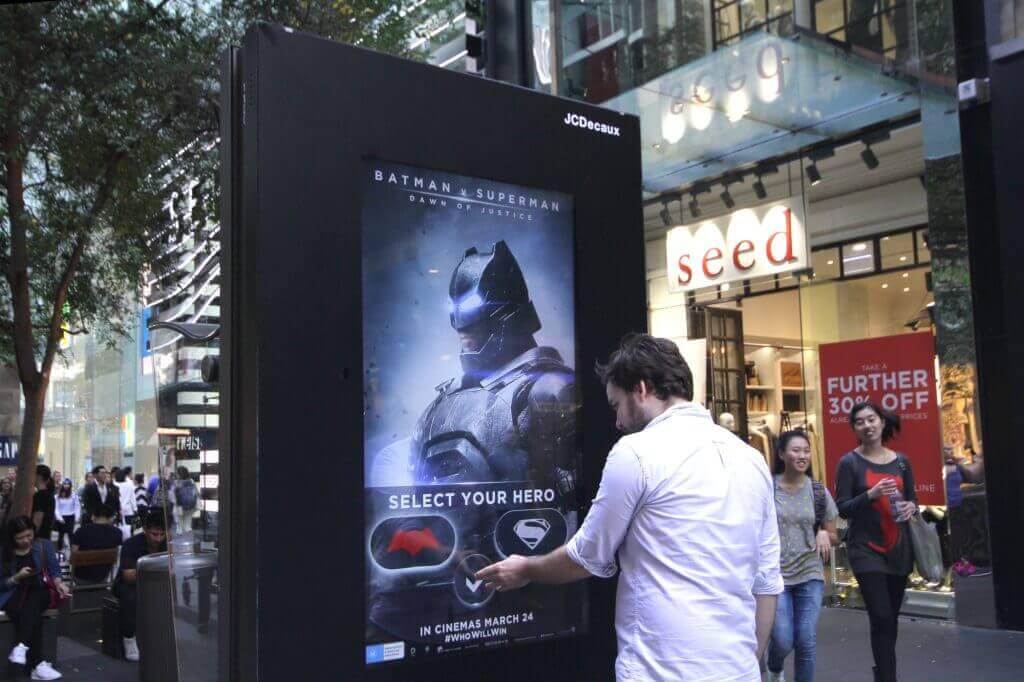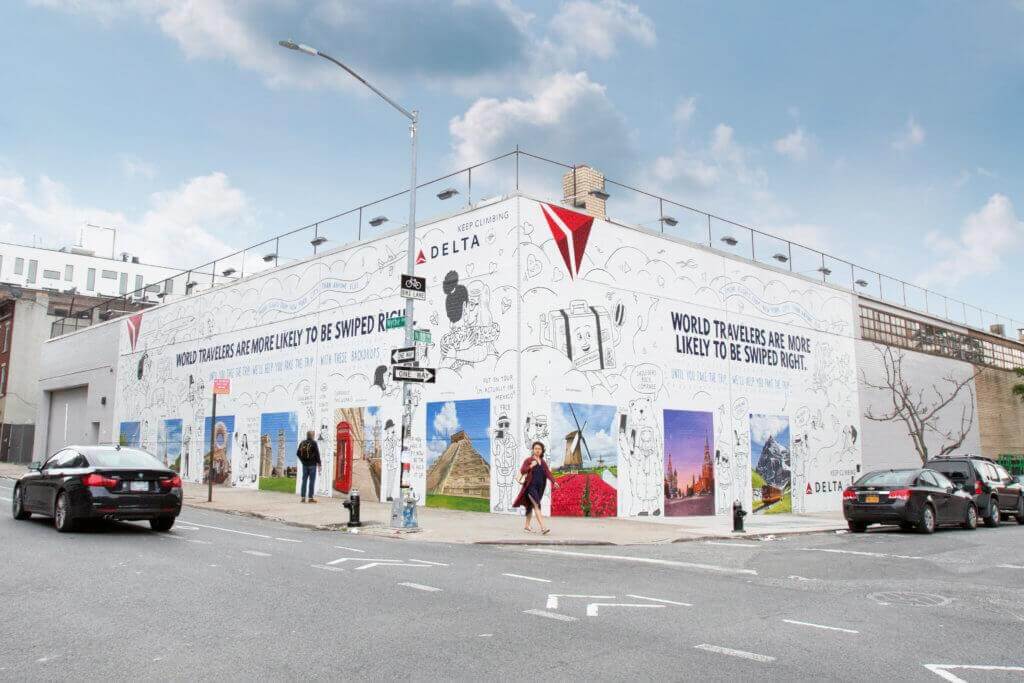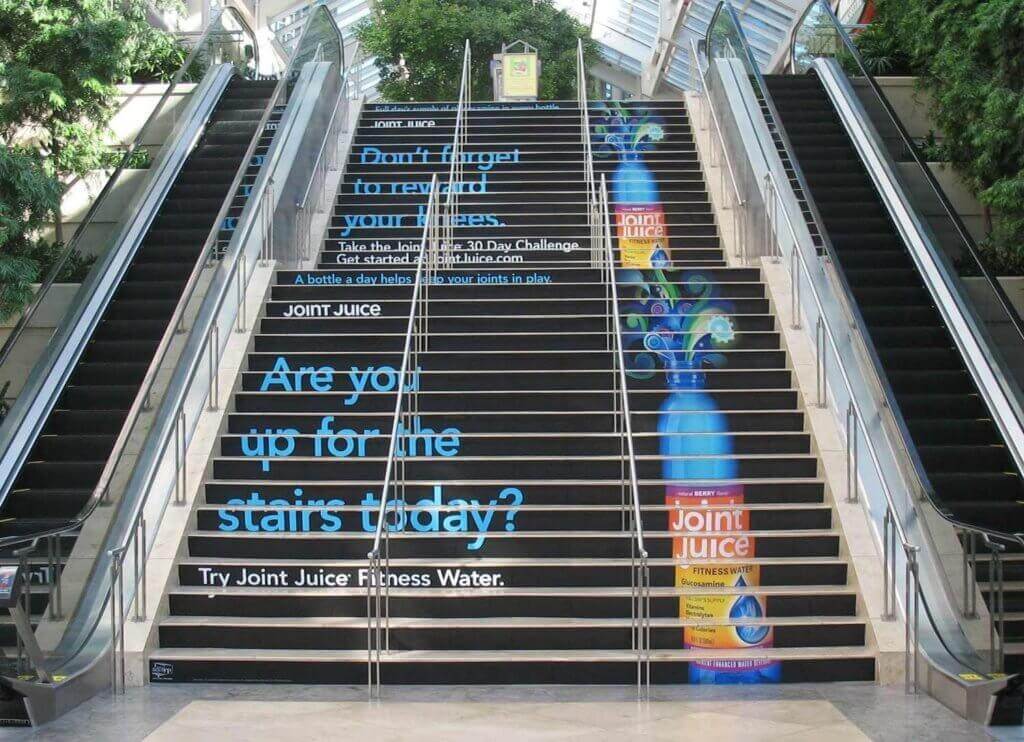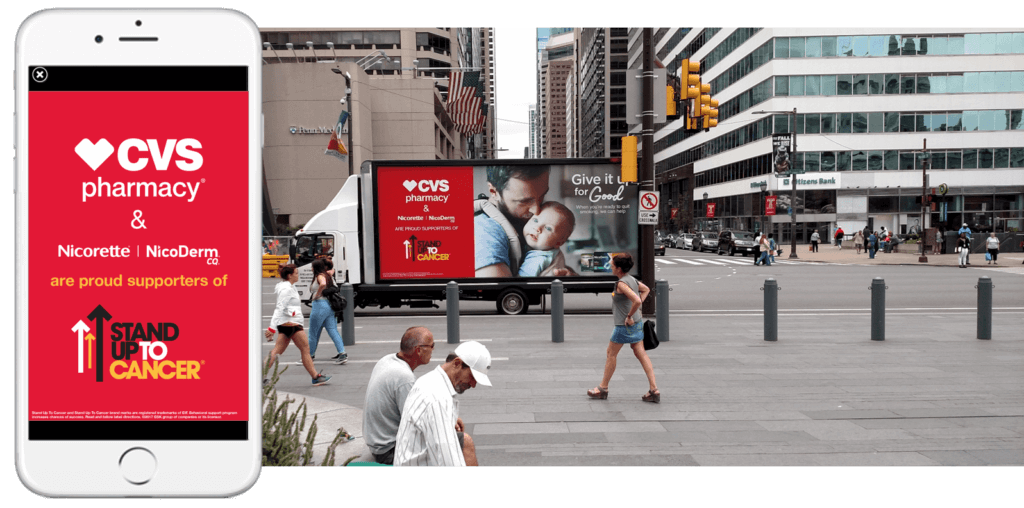
Nowadays, when people are out of their homes, they’re either in a hurry or constantly distracted by their phones. On top of that, with hundreds of additional distractions everywhere, your outdoor ad campaign can quickly get lost in a crowded advertising landscape and go unnoticed. This article outlines 6 key ways you can optimize your company’s out-of-home (OOH) marketing to make your campaign more memorable and eye-catching to people on-the-go.
1. Go digital
If you’ve been keeping up with out-of-home marketing trends in the past few years, you’ve likely come across digital out-of-home (DOOH) advertising. Accounting for 28.3% of all out-of-home advertising in 2019, digital OOH is a rising wave of immersive, captivating ads that incorporate motion to grab the attention of public transit users, drivers, pedestrians, mall shoppers, and more. It offers real-time programmatic automation, 24-hour visibility from far distances, and geo-targeting capabilities that traditional static print OOH simply does not stand a chance against. The truth lies in the numbers: a recent study in the UK found that digital OOH ads are twice as likely to be seen and 2.5 times more impactful than static OOH ads.
To really bring digital OOH to the next level, high-end advertisers have integrated seamless interactive features such as gesture/motion tracking, visual recognition, QR codes, augmented reality, touch enablement, and social media call-to-action to enhance consumer-brand connection. Thanks to digitization, out-of-home advertisements are brought to the forefront of commuters’ attention.

2. Make it share-worthy
The best out-of-home ads not only make people do a double-take, but stand out enough that they make people want to stop, snap a picture, and share it with their friends. Whether it’s an Instagram-worthy mural that people want to take a picture in front of, a cool installation that looks like it could belong in a museum, or something that makes people let out a small chuckle, the more time an ad gets, the more memorable your brand!

Take the Delta Airlines x Tinder joint 2017 campaign, ‘Dating Wall’, for example. Featuring nine of Delta’s top direct destinations, people passing by were invited to pose in front of the wall for a new Tinder profile picture. Named one of Adweek’s best campaigns of 2017, ‘Dating Wall’ was a huge hit for both companies and received buzz from online media outlets and local New Yorkers.
3. Location and timing are everything
Deciding where and when to place your out-of-home ads is just as important as making them eye-catching. Why? Consumers aren’t actively seeking to be impressed upon by your brand or your advertisements, so you have to bring your brand to them. Consider the market segment(s) and demographic(s) you want to target and their hot-spot locations at different times of the day. With mobile billboards and transit advertising, you can even strategize route selection to maximize exposure in multiple locations throughout a given day. If you want to contextualize your message, choose the right mix of locations in commercial, retail, industrial, or residential spaces.
When designing your out-of-home campaign, take advantage of the structures your ads will be placed on and make your ads contextually relevant for optimal impact. For example, is your ad on the side of a road, on a flight of stairs, on the side of a truck, at a bus stop, or on the side of a building? If your ads are not at eye-level, what can you do to catch the attention of people passing by?

4. Put it on wheels: the power of transit advertising
If you’re looking to catch the attention of as many people as possible or a highly specific demographic in one or several locations, then mobile advertising is the fit for your company! Mobile transit advertising can take the form of the interior and exterior of buses, trains, taxis, and subways, or mobile billboards on the sides of trucks. With the benefit of being at eye-level, drivers stuck in traffic or pedestrians walking by are more likely to catch a glimpse of your advertisement.
If you’re looking to stretch your marketing budget, mobile billboard advertisements are the way to go. Truck side advertising has one of the lowest large-format CPM (cost per thousand advertising impressions) out of any other type of out-of-home advertising medium. This means that for a fraction of the cost of static billboards or public transit advertising, truck side ads get equal, if not more, impressions! In fact, according to research done by the Truck Signage Network (TSN), commercial truck ads are 65% more effective than traditional advertising mediums, including static billboards.

5. More is more
Whether you’ve decided mobile, digital, or static out-of-home advertisements (or a combination of the three) are best for your campaign, it is essential to cover adequate OOH real estate to ensure your message is heard. In other words, it is not enough to impress an audience once. By placing more signs along a highway, more billboards across the city, or more trucks on the road, the average 40-67% one-time impression recall rate dramatically increases. In essence, the more that people see your ad, the more likely it is that they will remember your ad, and ultimately the more likely they are to be influenced by it.
6. Make a lasting impact with mobile retargeting
According to Outfront Media, one of North America’s largest outdoor media companies, consumers are 50% more likely to engage with a mobile ad after seeing the same ad from OOH first. This means that not only should you coordinate your brand messaging across online and offline advertisements, but you should also take advantage of mobile extension programs – otherwise known as geo-fencing. Geo-fencing is the use of GPS or RFID technology to create a virtual geographic boundary, enabling software to trigger a response when a mobile device enters or leaves a particular area. In other words, geo-fencing gives you data on who your out-of-home campaign reached – down to their demographic, location, and browsing behavior. Then, you can target devices with digital and social media ads based on if they match the criteria of your target audience, if they have visited competitor locations, or if they have entered physical locations.

As the effectiveness of digital and social ads is on a decline with mobile users rarely paying attention to them, mobile retargeting becomes a must for successful omnichannel marketing campaigns.
So, what are you waiting for?
It is no surprise that companies worldwide – from local businesses to tech giants – are increasing spending in out-of-home advertising. The reason? Even in the new age of smartphones, out-of-home remains one of the most effective forms of advertising with one of the highest revenue ROIs at $5.97. However, it isn’t enough to just place an ad anywhere. From innovative digital OOH to creative designs, mobile billboard advertisements to mobile retargeting, regardless of your budget, the time is now to optimize your company’s out-of-home campaign to send the right message, at the right time, and to the right people.


